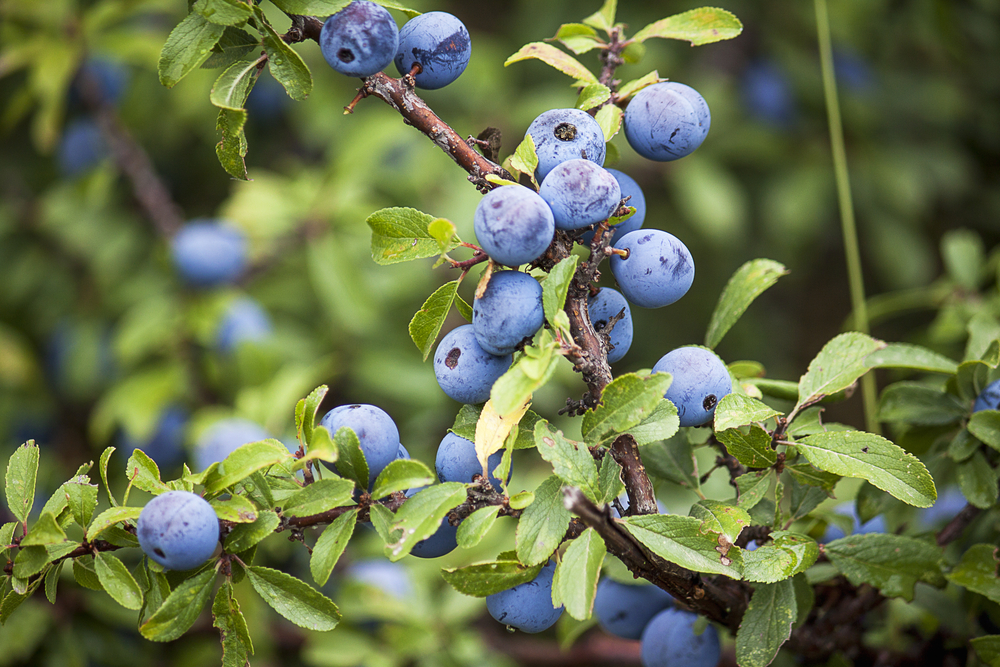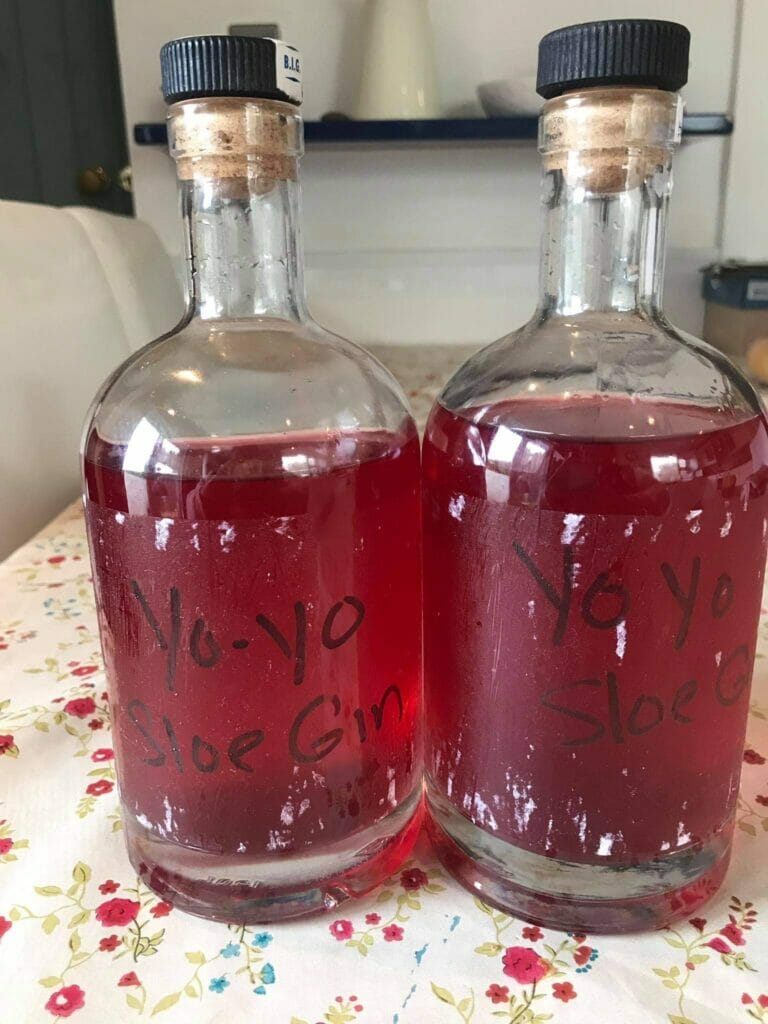When the World Slowed Down, I Made Sloe Gin
Grown throughout the English countryside, the tart berries can be used to make a festive liqueur.
When the World Slowed Down, I Made Sloe Gin
Grown throughout the English countryside, the tart berries can be used to make a festive liqueur.

Sloe gin, a British red liqueur, is made by infusing sloe berries in high-proof gin. by Steidi, Shutterstock.
In 2020, our lives were turned upside down when a global pandemic ensued and shut the world down for many months. That summer, we were provided with some normalcy, as the borders opened back up and travel started up again. But by October, I was in Ireland, living on strict lockdown again and desperately in need of a project to keep myself busy.
For several years, I’d been thinking about making my own alcohol, and sloe gin was on the top of the list. Compared to other spirits, sloe gin is relatively easy to make at home. The British gin-based liqueur is the result of infusing sloe berries and sugar in a high-proof gin.
In the same family as plums and cherries, sloe berries are the fruit of the blackthorn plant (Prunus spinosa). They’re native to the UK, Ireland and other parts of Europe, where this bitter and sour berry has been used to flavor jams and alcoholic beverages like sloe gin for centuries.

While it’s not as popular in America, sloe gin has deep roots in the UK. Beginning as early as the seventeenth century, Parliament passed a series of enclosure acts that transformed common land into individual farmsteads and properties. These laws allowed the rich to claim open land, on which bushes such as the blackthorn were used to mark the edges of fields, resulting in abundance of sloe berries across the countryside. Eventually, farmers found a use for these inedible berries, which are at their most ripe in late September and October. Being that it took a few months to infuse the sloe berries into a tasty winter aperitif, it became the alcohol to drink around Christmas time.
Of course, sloe gin was never as popular as gin itself, as the fruit liqueur was thought of as the poor-man’s Port. But by the nineteenth and twentieth centuries, sloe gin began making a comeback as distilleries started to make their own brands and cocktails. This included the “Sloe Gin Fizz,” that would make this tart liqueur popular again. In the last few years, thanks to its revival, British distilleries such as Sipsmith, Plymouth Gin and Monkey 47 have also been making and importing sloe gin to the US. There are even some American distilleries, such as Spirit Works Distillery in Sebastopol, California, that make versions of sloe gin by importing the berries.
I got my first taste of sloe gin in 2014, and was excited to finally try my hand at making my own. Foraging these tart berries had always eluded me, as I was never in Ireland during the autumn when sloe berries are ripe for picking. So, last fall, with help from a friend, I finally was able to get a bucketful of berries and started on my DIY sloe gin journey.
In addition to sloe berries, gin and sugar, the process of making sloe gin requires a whole lot of patience. The longer it sits, the better your sloe gin will taste. After a few months, the gin evolves into a sweet ruby-colored liqueur that is a great winter treat that makes tasty drinkable gifts for friends and family. Time is of the essence, and if you want to have your sloe gin by Christmas, you have to start making it by September, as it takes one to three months for alcohol to infuse.

As I endured another lockdown last October, I watched my boozy concoction evolve into a sweet treat. I would check my bottles, watching as the sugar dissolved and the berries went from dark to light. I counted down the days until I could sip on my libation—and be free from isolation.
Sloe berries are not commonly grown in the US, but there are other ways to enjoy this homemade drink, like substituting other berries that are in the same family. For example, Damson or beach plums are both ideal alternatives because they are similar in taste and will result in a similarly fruity liqueur. If you are keen on making the real deal, then the Internet is your friend. You can place a wholesale order for sloe (blackthorn) berries to be delivered to your home. And if you’re lucky, you might even find a local farm that grows them.
As for myself, I decided to make foraging for sloe berries an annual tradition while I’m living abroad. This year, I was a little late gathering my berries, so my sloe gin won’t be ready in time for Christmas. But in 2022, I know my cup will be overflowing with my homemade boozy treat for future chilly, winter days.
Follow us
This work is licensed under a Creative Commons Attribution-NoDerivatives 4.0 International License.
Want to republish a Modern Farmer story?
We are happy for Modern Farmer stories to be shared, and encourage you to republish our articles for your audience. When doing so, we ask that you follow these guidelines:
Please credit us and our writers
For the author byline, please use “Author Name, Modern Farmer.” At the top of our stories, if on the web, please include this text and link: “This story was originally published by Modern Farmer.”
Please make sure to include a link back to either our home page or the article URL.
At the bottom of the story, please include the following text:
“Modern Farmer is a nonprofit initiative dedicated to raising awareness and catalyzing action at the intersection of food, agriculture, and society. Read more at <link>Modern Farmer</link>.”
Use our widget
We’d like to be able to track our stories, so we ask that if you republish our content, you do so using our widget (located on the left hand side of the article). The HTML code has a built-in tracker that tells us the data and domain where the story was published, as well as view counts.
Check the image requirements
It’s your responsibility to confirm you're licensed to republish images in our articles. Some images, such as those from commercial providers, don't allow their images to be republished without permission or payment. Copyright terms are generally listed in the image caption and attribution. You are welcome to omit our images or substitute with your own. Charts and interactive graphics follow the same rules.
Don’t change too much. Or, ask us first.
Articles must be republished in their entirety. It’s okay to change references to time (“today” to “yesterday”) or location (“Iowa City, IA” to “here”). But please keep everything else the same.
If you feel strongly that a more material edit needs to be made, get in touch with us at [email protected]. We’re happy to discuss it with the original author, but we must have prior approval for changes before publication.
Special cases
Extracts. You may run the first few lines or paragraphs of the article and then say: “Read the full article at Modern Farmer” with a link back to the original article.
Quotes. You may quote authors provided you include a link back to the article URL.
Translations. These require writer approval. To inquire about translation of a Modern Farmer article, contact us at [email protected]
Signed consent / copyright release forms. These are not required, provided you are following these guidelines.
Print. Articles can be republished in print under these same rules, with the exception that you do not need to include the links.
Tag us
When sharing the story on social media, please tag us using the following: - Twitter (@ModFarm) - Facebook (@ModernFarmerMedia) - Instagram (@modfarm)
Use our content respectfully
Modern Farmer is a nonprofit and as such we share our content for free and in good faith in order to reach new audiences. Respectfully,
No selling ads against our stories. It’s okay to put our stories on pages with ads.
Don’t republish our material wholesale, or automatically; you need to select stories to be republished individually.
You have no rights to sell, license, syndicate, or otherwise represent yourself as the authorized owner of our material to any third parties. This means that you cannot actively publish or submit our work for syndication to third party platforms or apps like Apple News or Google News. We understand that publishers cannot fully control when certain third parties automatically summarize or crawl content from publishers’ own sites.
Keep in touch
We want to hear from you if you love Modern Farmer content, have a collaboration idea, or anything else to share. As a nonprofit outlet, we work in service of our community and are always open to comments, feedback, and ideas. Contact us at [email protected].by Yolanda Evans, Modern Farmer
December 24, 2021
Modern Farmer Weekly
Solutions Hub
Innovations, ideas and inspiration. Actionable solutions for a resilient food system.
ExploreExplore other topics
Share With Us
We want to hear from Modern Farmer readers who have thoughtful commentary, actionable solutions, or helpful ideas to share.
SubmitNecessary cookies are absolutely essential for the website to function properly. This category only includes cookies that ensures basic functionalities and security features of the website. These cookies do not store any personal information.
Any cookies that may not be particularly necessary for the website to function and are used specifically to collect user personal data via analytics, ads, other embedded contents are termed as non-necessary cookies.